Introduction to the Kgalagadi Transfrontier Park
The Kgalagadi Transfrontier Park in South Africa is our favorite place in the world, our happy place. We love the rolling red sand dunes dotted with sage green grass and the cobalt-blue skies filled with puffy white clouds. We love that this massive area is a true wilderness, an intact ecosystem functioning essentially the same as it has for millennia. We love that the sparse vegetation makes for unparalleled viewing and photography. We love that the remoteness and fairly well-managed development keeps visitor numbers low enough that you can be all alone with an incredible sighting.
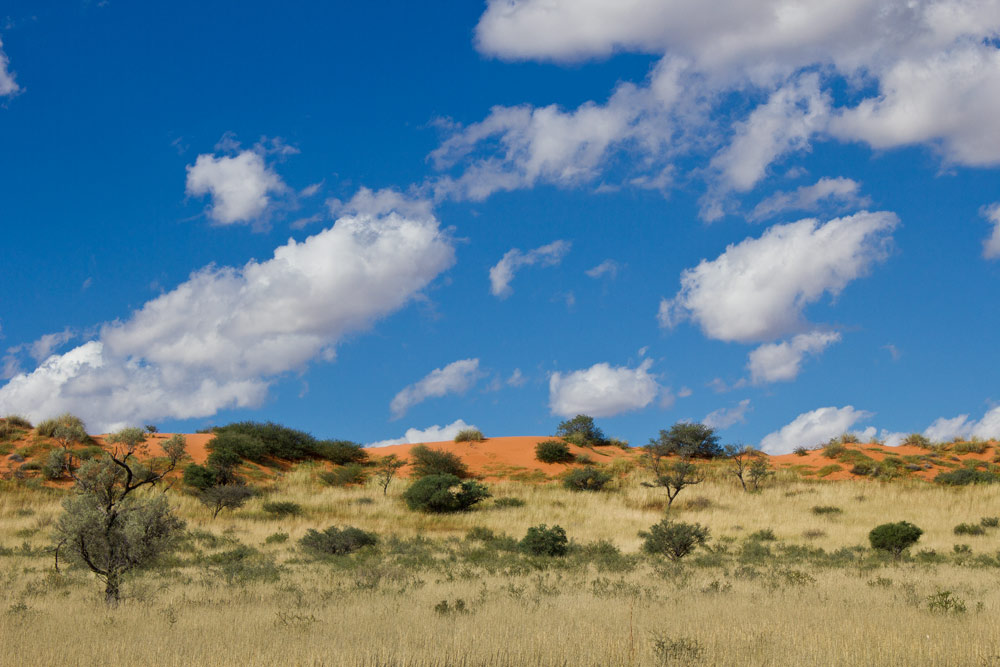
But what we love most are the animals. A surprisingly complex web of life has adapted to survive in this arid environment, including an all-star cast of large predators. We’ve spent more than six months of our lives inside the park over the last two decades and we plan to spend many more. Here is our visitor’s guide to the Kgalagadi Transfrontier Park based on our own personal experiences.
Table of Contents
- Introduction to the Kgalagadi Transfrontier Park
- What is a Transfrontier Park?
- Is the Kalahari a Desert?
- A Guide to the Kgalagadi
- How to Pronounce Kgalagadi
- Things to Know Before You Go to the Kgalagadi
- Wildlife of the Kgalagadi
- How to Get There
- When to visit the Kgalagadi Transfrontier Park
- Can I Self-Drive in the Kgalagadi?
- Where to stay in the Kgalagadi
- What to Bring
- Kgalagadi Photography Tips
- Rules when visiting the Kgalagadi
- Frequently Asked Questions:
- Do I need a passport?
- How do I contact the Kgalagadi National Park office?
- Can I enter the park if I don’t stay in the park overnight?
- Can I bush camp in the wilderness or on the side of the road?
- Can I just drive through the park to cross into another country in one day?
- Is the Kgalagadi malaria free?
- Are the camp shops well stocked?
- Is there an ATM in the park?
- What currency can I use?
- Are there gas stations in the park?
- Is there wifi in the Kgalagadi?
- Do I need to bring my own water?
- Conclusion
What is a Transfrontier Park?
A Transfrontier Park (also known as a Peace Park) is a park that exists across an international border with no fences in between. The Kgalagadi was the first official transfrontier park in all of Africa! Two national parks, The Kalahari Gemsbok Park of South Africa and the Gemsbok National Park of Botswana, were merged in 1999 to become a single park, officially opening in 2000. The way it works is that there is a formal agreement made by both countries to manage all areas as one unit according to a streamlined management plan.
*This article may contain affiliate links. We receive a small commission at no extra cost to you.*
Is the Kalahari a Desert?
The Kgalagadi Transfrontier park (or KTP) lies in the Southwest corner of the Kalahari, a vast expanse of sand covering most of Botswana and parts of Namibia and South Africa. (See the Kgalagadi Map below.) It is sometimes referred to as the Kalahari Desert, but it is more accurately termed a semi-desert. An area that receives less than 255 mm of rain per year is called a desert, but the average across the entire Kalahari is slightly higher than this. In the extreme southwest of the Kalahari where the KTP lies, however, the rainfall is lowest, averaging 200 mm per year, placing it firmly within the definition of a desert. So while the entire Kalahari is not a desert, the Kgalagadi Transfrontier Park does experience desert levels of rainfall. A more accurate name is the Arid Kalahari or simply the Kalahari.
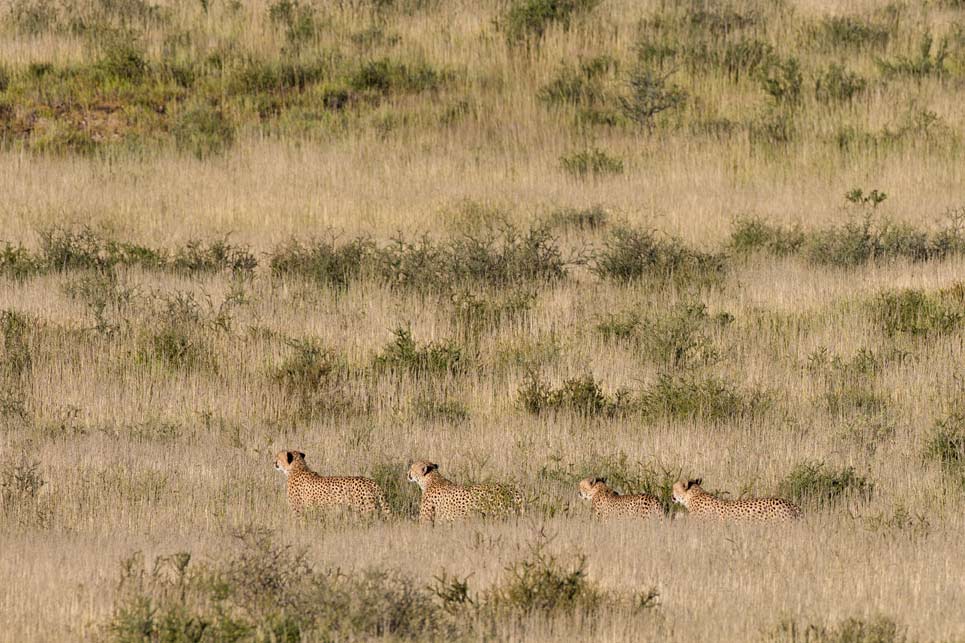
A Guide to the Kgalagadi
The park spans more than 37,000 square kilometers in both South Africa and Botswana making it one of the largest conservation areas in the world. The Botswana side is less developed and contains 75% of the park. The South Africa side has much more tourist infrastructure, as well as the majority of the iconic red sand dunes. These dunes have been stationary for thousands of years due to the stabilizing effect of grasses, shrubs, and trees.
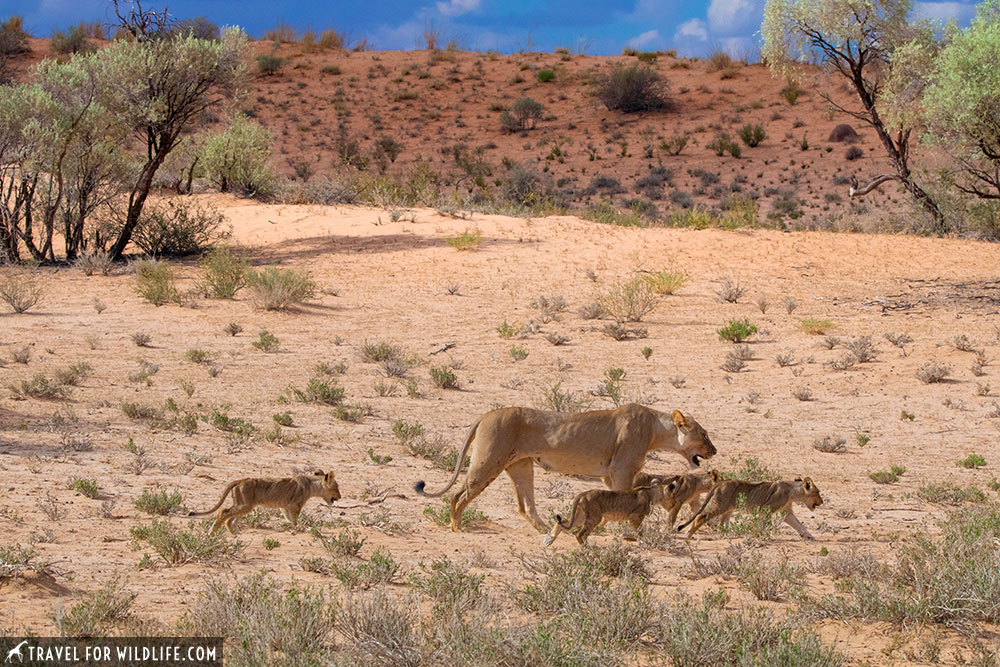
The two main roads in the park follow fossil river beds that cut through the dunes. These rivers no longer flow and only carry water in periods of exceptionally high rainfall, perhaps a couple times each century. In fact, there hasn’t been a permanent source of water in the region for millennia. It was only in the last hundred years that boreholes were drilled, first as a water supply for an impending war, now supplying waterholes that have become a focal point for wildlife.
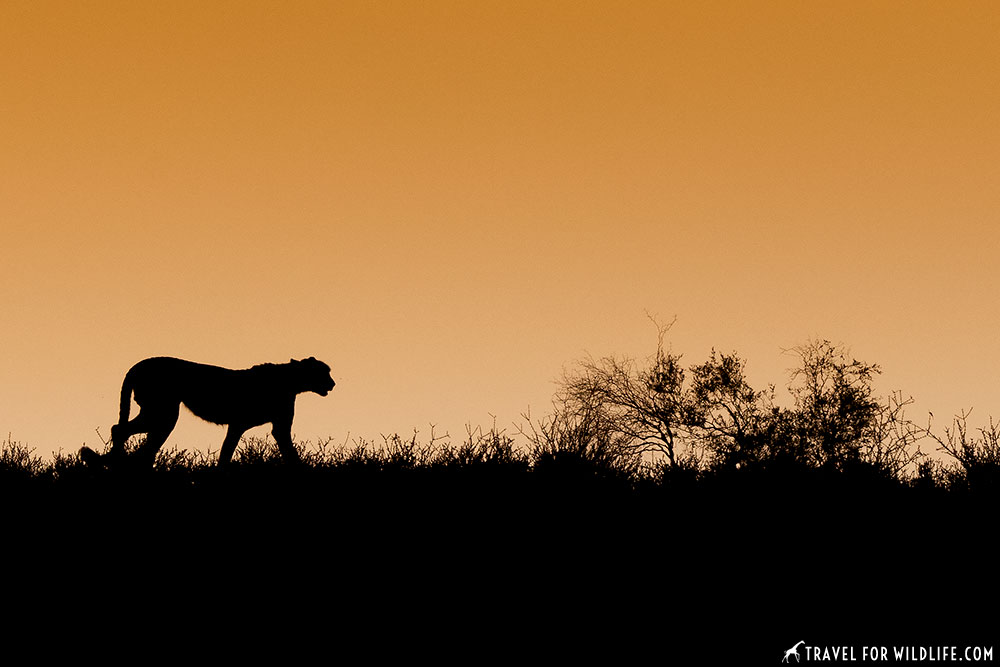
Kgalagadi Map
This Kgalagadi map shows the location of the Kalahari “Desert” in Southern Africa as well the location of the Kgalagadi Transfrontier Park within the Kalahari. It spans the border of South Africa and Botswana and shares its western border with Namibia.
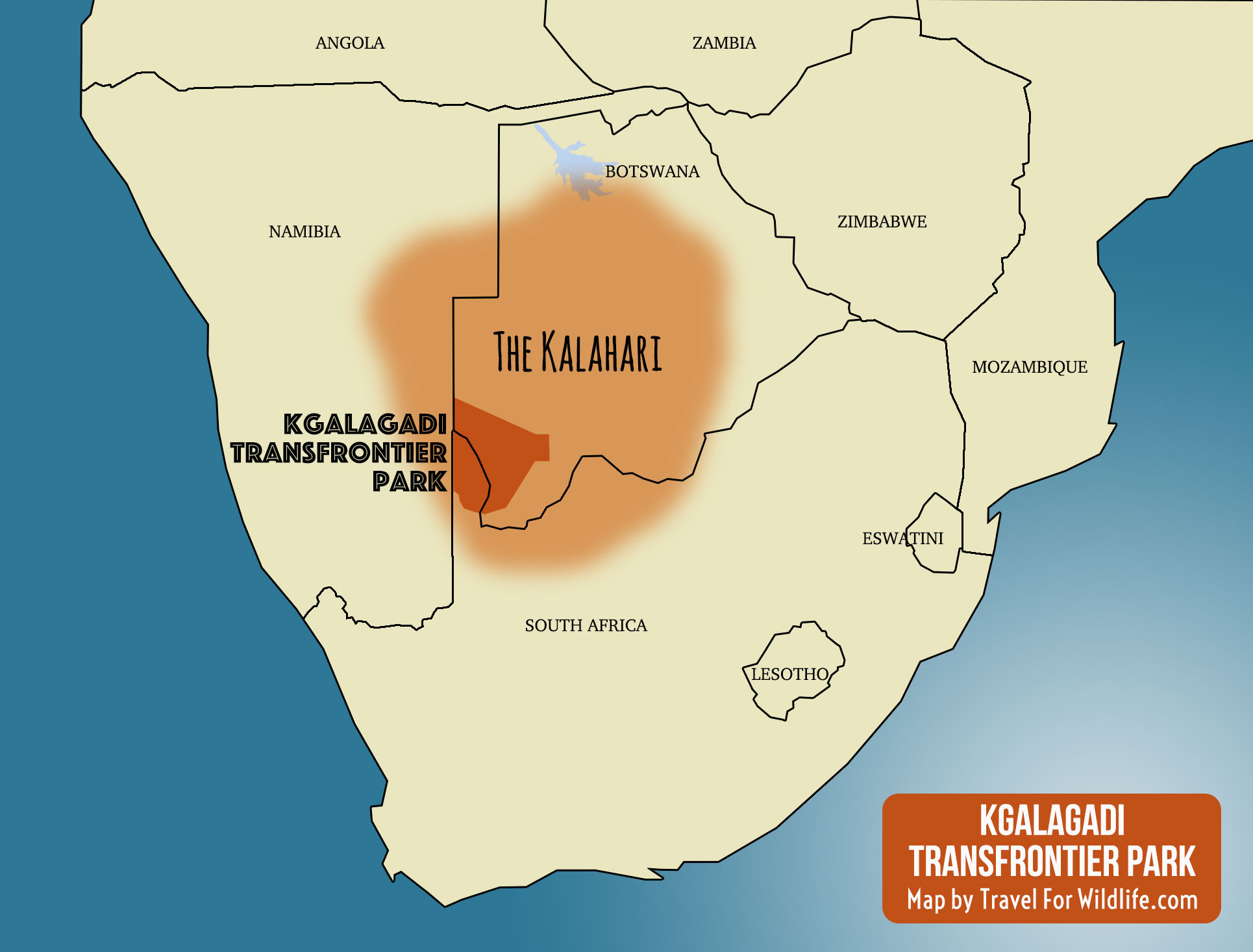
For a more detailed Kgalagadi map including all the roads, camps, and waterholes download the official park map of the Kgalagadi Transfrontier Park. Don’t worry, they’ll give you a map at reception when you check in.
How to Pronounce Kgalagadi
One of the first questions you may ask is how to pronounce Kgalagadi? The easiest way is to simply pronounce it the same way you say Kalahari. The word Kgalagadi is said to be derived from the Kgalagadi people’s word for salt pans: Makgadikgadi. In the Afrikaans language (one of the prominent languages in South Africa), the letter g is pronounced sort of like a rough-throated h-sound or gh-sound (you know, pretend you are coughing up some phlegm) so you will often hear it pronounced ha-la-ha-dee (or gha-la-gha-dee). I know, it’s a little tough if you’re not a native Afrikaans or Dutch speaker. That’s why we just tend to say Kalahari!
Things to Know Before You Go to the Kgalagadi
This isn’t your average national park. There are challenges here, from difficult driving conditions to extreme weather. The remote location and huge open spaces mean if something goes wrong you could be stuck for hours, or even overnight, without help.
For this reason, the South Africa side of the park uses a permit system to make sure you make it safely into a camp each night. Basically you turn in your permit each evening when you enter a camp and you pick it up again when you go for your morning drive, informing the staff member which direction you intend to go. If a visitor doesn’t turn up at their designated camp, a staff member has to go searching for them.
On the Botswana side things are even more remote, especially in the Mabuasehube and in the Kaa regions! Nobody is keeping track of where you are. You must be completely self-sufficient, carry all your own water, and be prepared in case of emergency. There are no fences, no chalets, no electricity, no water (with a few exceptions), no shops, no gas stations, no ATMS. Nothing but sand and a few basics at each primitive camp site. Read our article about Visiting Mabuasehube and our Complete Guide to the Mabuasehube Campsites for more info.
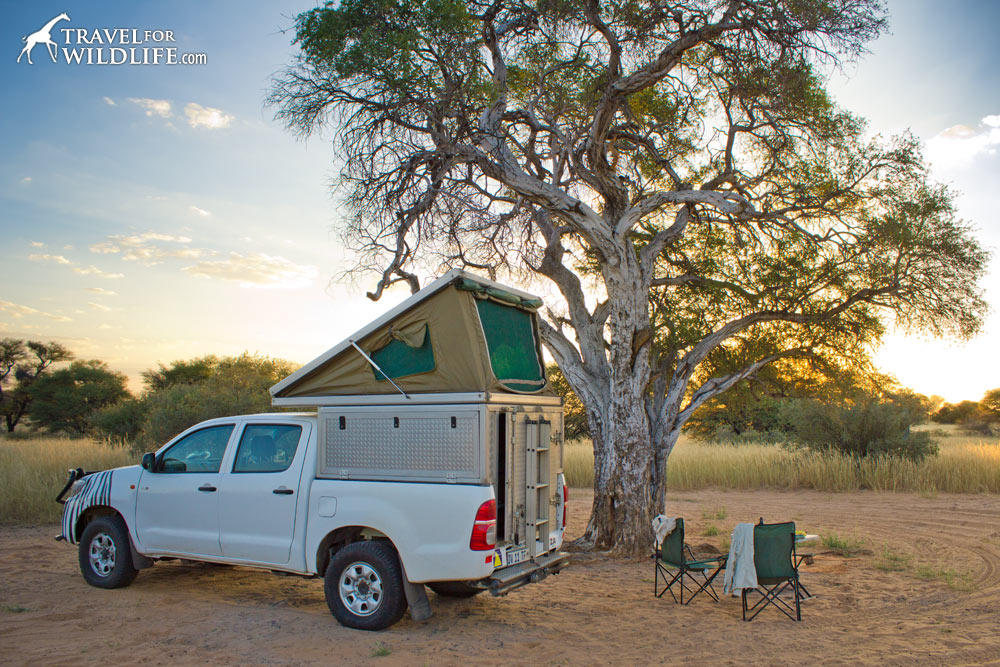
Also keep in mind there is no phone reception in the entire park. You may be able to pick up some signal from South Africa’s Vodaphone network in Twee Rivieren. Staff in Mata Mata told me they can sometimes get access to Namibia’s MTC network (though it didn’t work for us.) However, there is wifi now available in the three main camps and you can buy a voucher for it at the shops (see FAQ’s at the bottom of this article.)
Wildlife of the Kgalagadi
A wide variety of predators combined with great visibility and beautiful landscapes makes the Kgalagadi a haven for wildlife watchers and photographers. We consider the Kalahari the best place in the world to view and photograph big cats in a beautiful, unspoiled wilderness setting with very few people around.
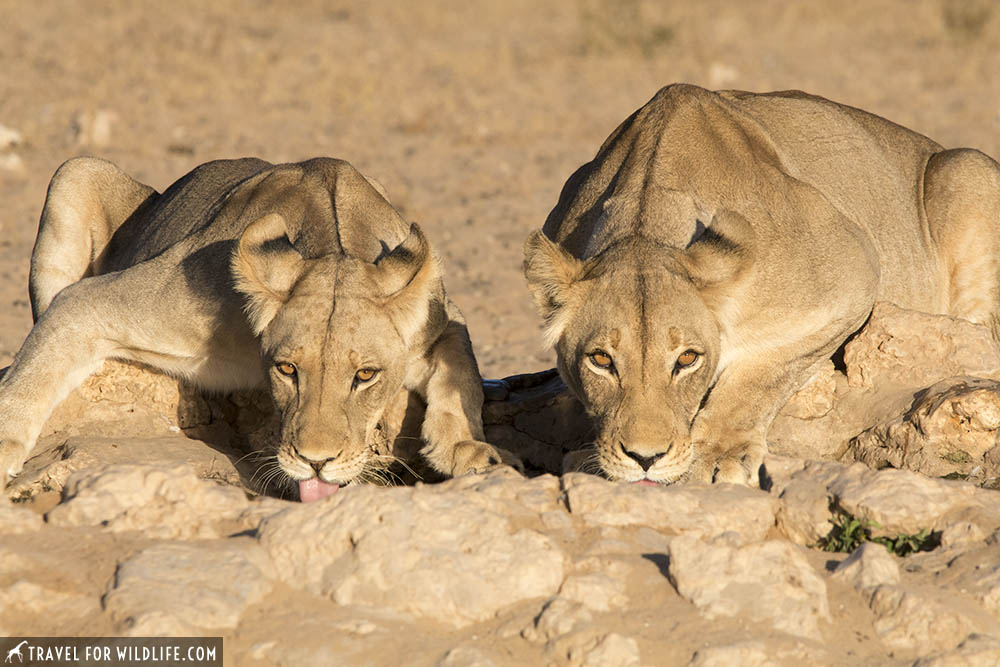
At first glance the Arid Kalahari may look like a desolate place that couldn’t support life, but in reality it is filled with a surprisingly complex web of creatures. You won’t find the same diversity as, say, in Kruger National Park (probably the highest wildlife diversity in all of Africa), but this shouldn’t be surprising considering there hasn’t been a permanent water source here for millennia! And yet, thousands of species from lizards to lions have adapted to survive in this harsh climate.

Kalahari Mammals
While 60 mammal species may not seem especially high for such a vast region, keep in mind that nearly a third of them are predators! This makes for some very exciting mammal watching. Like this video below of leopard cubs!
Kalahari Hoofed Mammals: While the lack of water prevents the Kgalagadi from having the biggest African mammals like Elephant, hippo, and rhino, you will still find an impressive array of ungulates, including the tallest of all (the giraffe) and the largest antelope (the eland). The most commonly seen antelope include springbok, wildebeest, red hartebeest, and the supremely desert-adapted gemsbok, also known as the oryx, which is the iconic symbol of the Kalahari (see our Gemsbok facts). You may even spot the occasional kudu. Cross one of the dune roads and keep your eyes peeled for the secretive steenbok. Toward the eastern end in Botswana you can even enjoy the antics of warthogs.
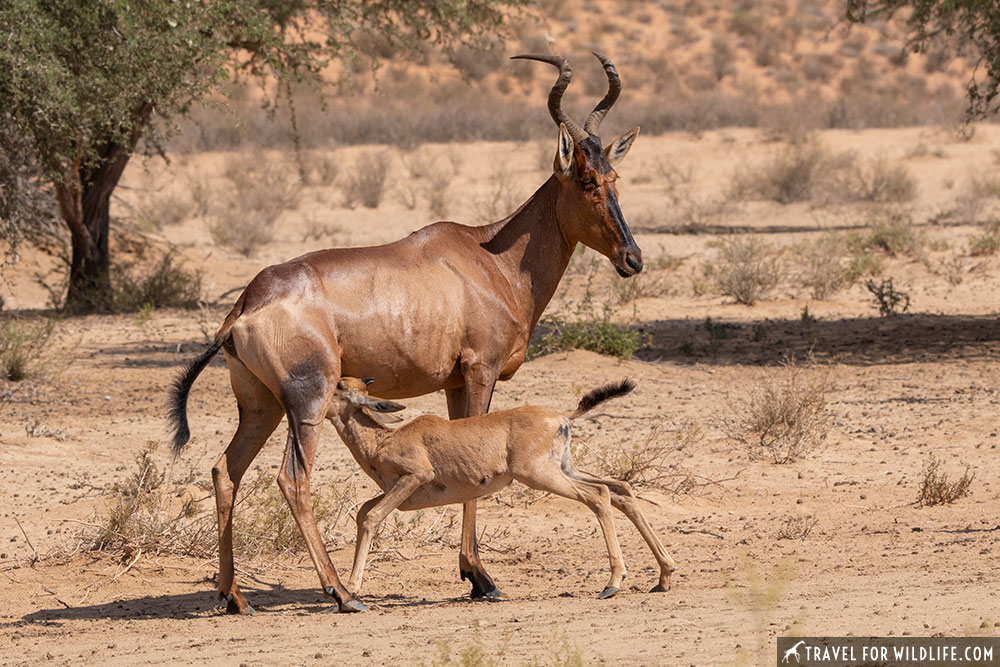
Kalahari Cats: Something you will find in abundance is carnivores. The Kalahari is a cat-watchers paradise with 5 cat species commonly seen in the park. We consider the Auob riverbed to be the best place in the world to watch cheetahs hunting.
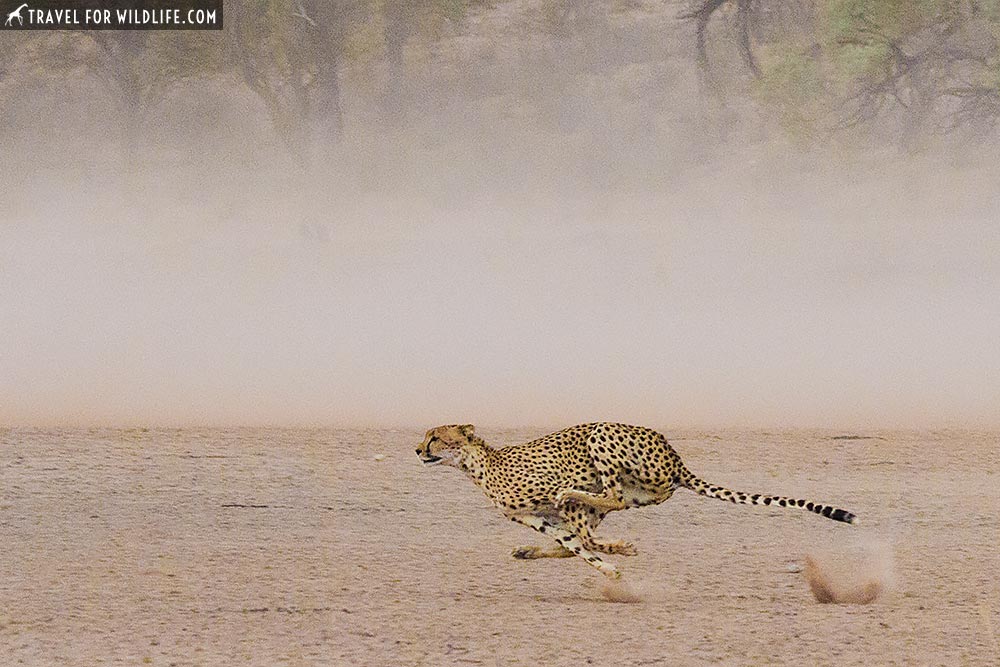
And if you want to see lions, you’ve come to the right place.During our one-month visit in 2020 we had 45 separate lion sightings representing at least 60 different individuals, including 19 small cubs! (Also check out our post What Do Lions Eat.) In most large national parks you’ll have to fight through a large traffic jam around any lion sighting, but not here. For the best chance of spotting a caracal watch the waterhole all night at wilderness camps such as Urikaruus and Grootkolk.
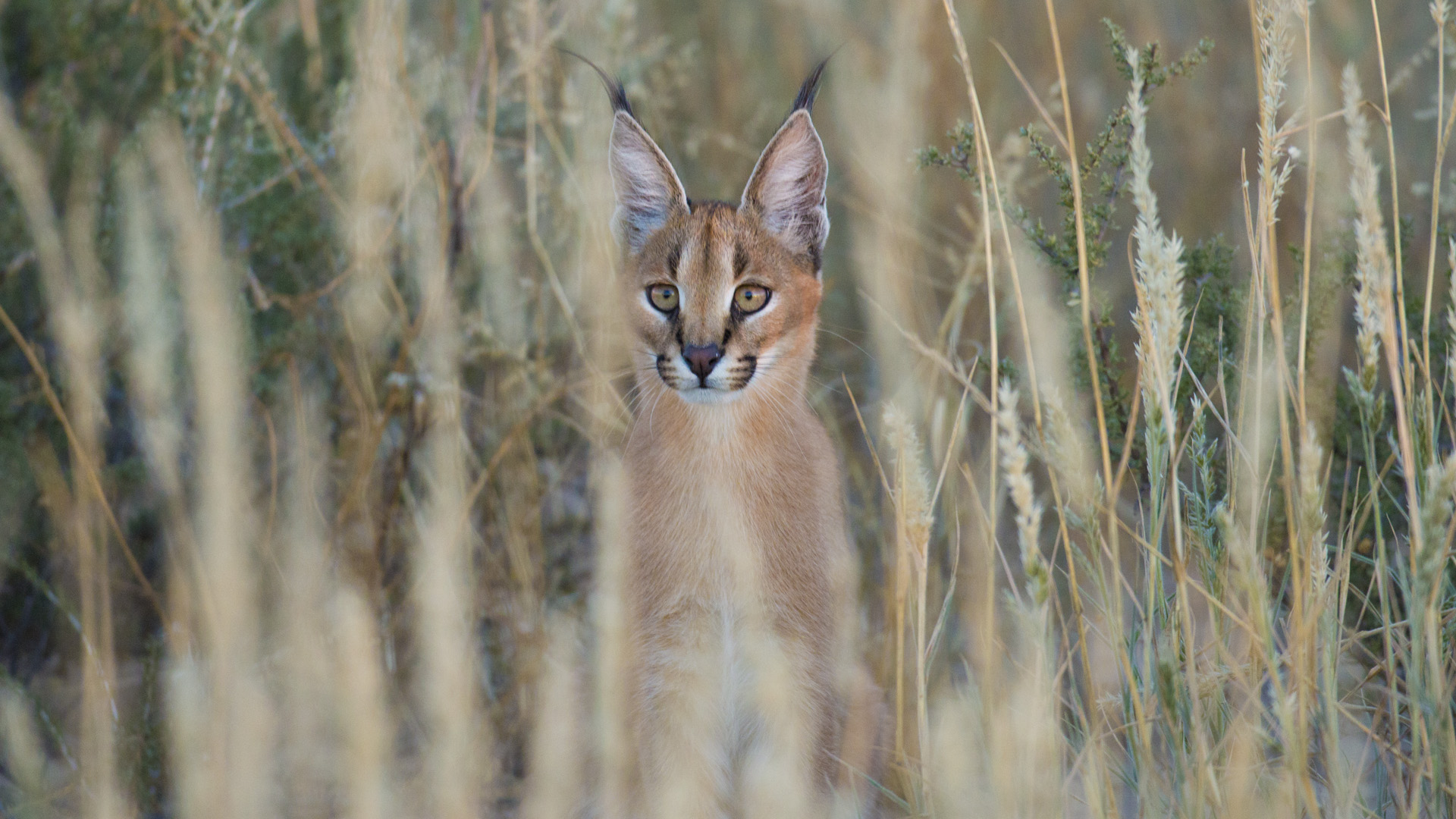
A guided night drive out of Mata Mata or Twee Rivieren offers high odds of seeing an African wild cat on the prowl, the ancestor of the domestic cat. The most coveted sighting is the elusive leopard, in my opinion the most beautiful of the big cats. Some individuals are occasionally seen in the riverbeds such as this female known as Miera with her two newborn cubs in 2020!
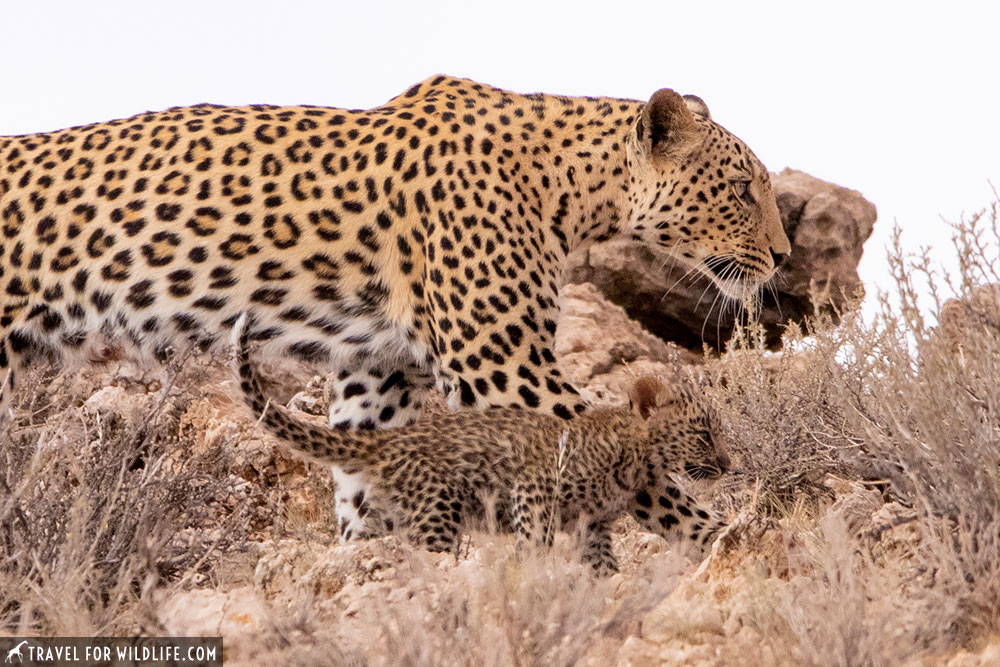
Other Kalahari Predators: Many other predators large and small are commonly sighted. Three hyena species are present including the spotted hyena and the brown hyena best viewed in early morning. Rarely a visitor may glimpse an aardwolf entering a den on the dune roads, a highly specialized hyena that eats termites. Canids include the ubiquitous black-backed jackal, and the less frequently sighted cape fox. On chilly days you may spot the comical bat-eared fox foraging at sunset. Smaller carnivores include the honey badger, small-spotted genet, yellow mongoose and slender mongoose, as well as the much-loved meerkat.
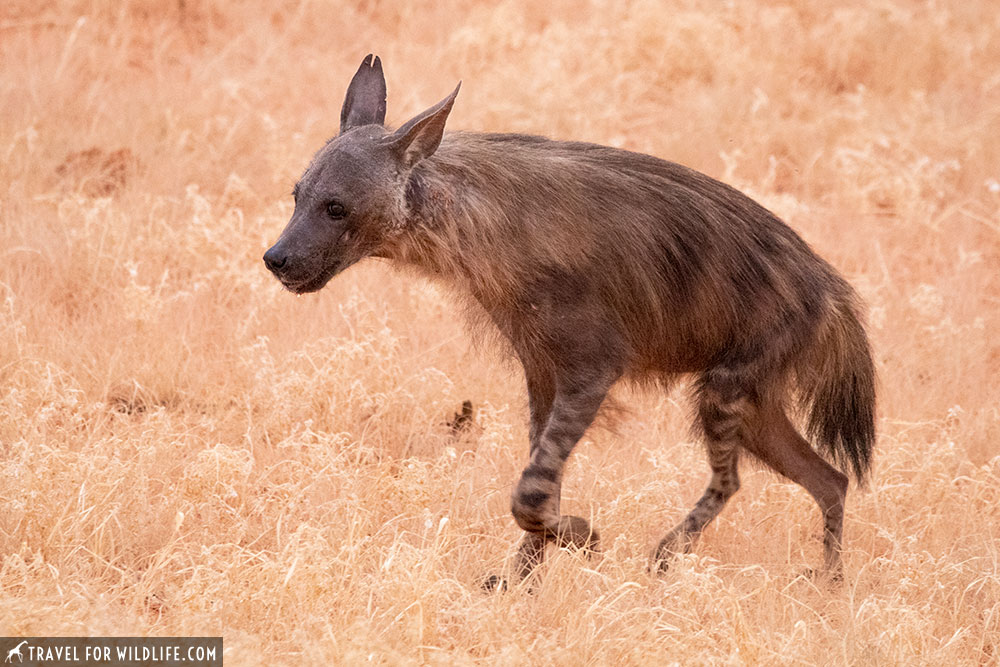
Rare Mammal Treats: The cape ground squirrel is the only rodent you’re likely to spot on a daily basis, but the nocturnal porcupine and springhare are fascinating rodents you can glimpse on a night drive. If you’re even luckier you may catch a glimpse of the bushveld elephant shrew, which is one of the Little Five animals of Africa, ( see video below) or the very shy aardvark or pangolin.
Kalahari Birds
The Kgalagadi Transfontier Park is a bird-watchers paradise. Of the more than 300 species recorded in the park, roughly half of them are year round residents or regular visitors. You can readily watch the largest bird in the world, the ostrich, the mischievous hornbills, or the world’s heaviest flying bird, the kori bustard. There are so many birds to choose from that we can’t dive too deep here (stay tuned for our Kalahari Birds post coming soon.) But what we love most about Kgalagadi birding is how easy it is to watch an incredible variety of raptor species.
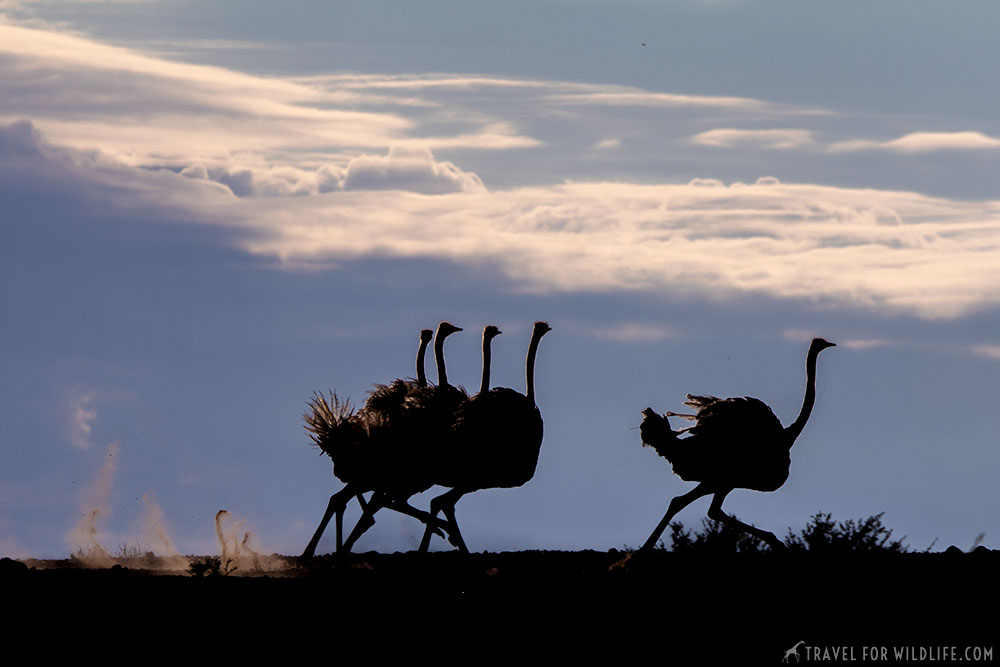
Kalahari Birds of Prey: Tawny Eagles and Bateleurs are a common sight around the waterholes. Huge secretary birds stride through the grasslands in search of reptiles. Lanner falcons scream through the air like jet planes in pursuit of doves. Massive lappet-faced vultures pace around carcasses while white-backed vultures wait for them to tear in.
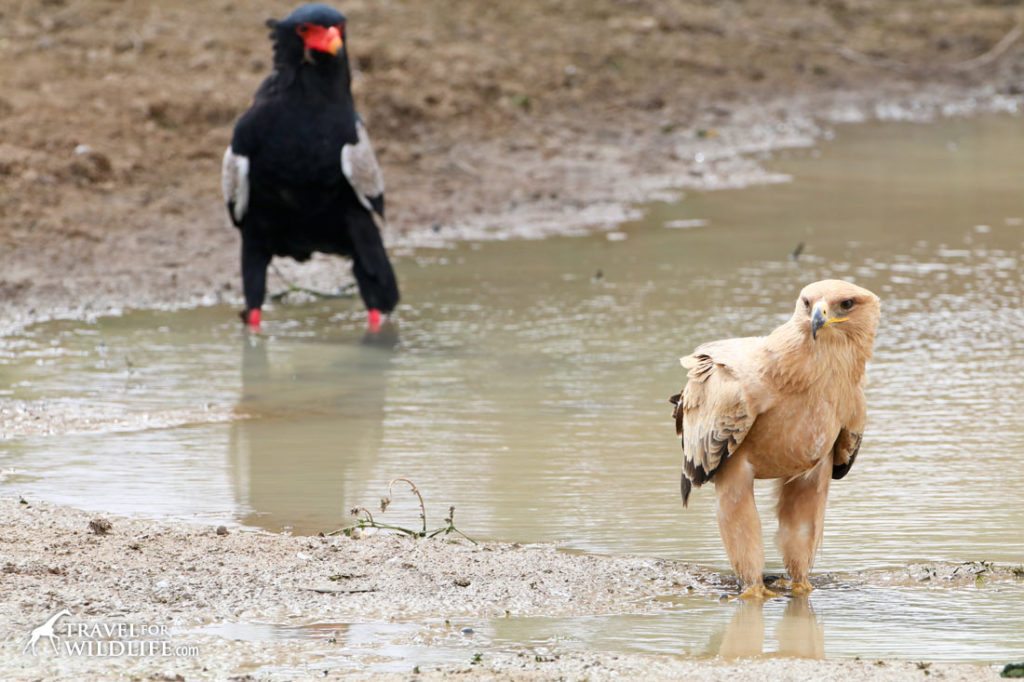
Pale-chanting goshawks call conspicuously from tree tops while the gabar goshawks hide quietly inside. The park is also a hot spot for African owls. A giant eagle owl with its pink eyelids screeches from the top of your chalet in Twee Rivieren, while resident barn owls may be found in every wilderness camp. (Check out our post South African Owls for more info.) The largest eagle in Africa, the martial eagle, swoops down to catch a springbok lamb. And this is just a small taste of the more than 36 raptor species regularly sighted in the Kgalagadi.
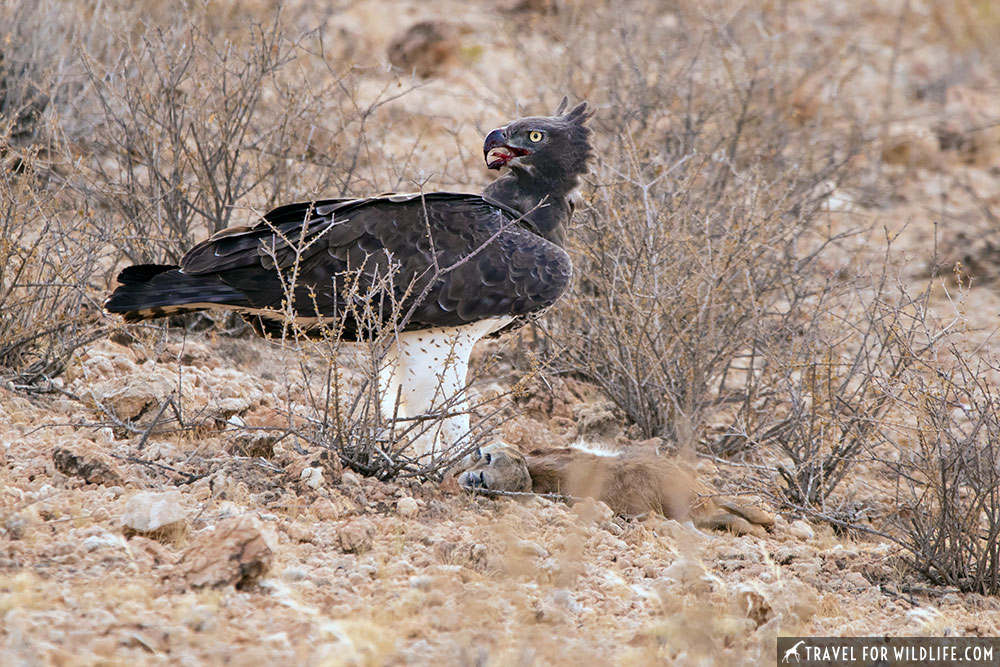
Kalahari Reptiles and Amphibians
It may be surprising to learn that such a dry region supports as many as 9 frog species, including the giant bullfrog, up to eight inches long from nose to tail! They emerge from aestivation after large rainstorms and must quickly breed and return into the mud underground before puddles dry up.
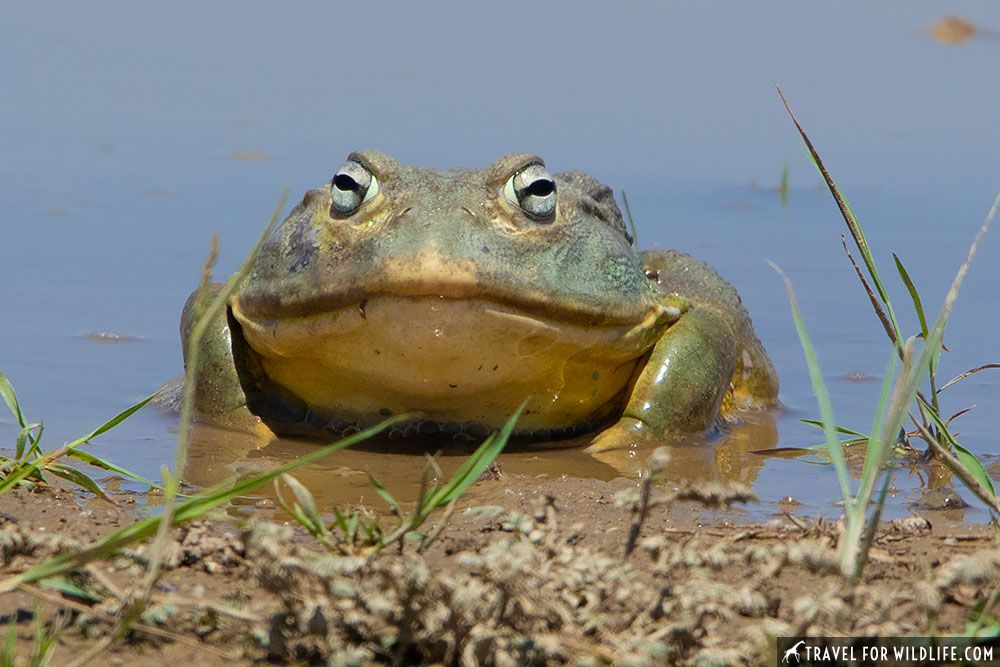
Several conspicuous snakes include the beautiful yellow-orange cape cobra (watch a cape cobra video here) and the stocky puff adder. We even spotted a horned adder by the blind in Twee Rivieren! The two tortoises found here are the large leopard tortoise, commonly seen going for a stroll after a rain, and the small and rarely seen Kalahari tent tortoise. We even once sighted the only aquatic turtle in the region, the marsh terrapin, in a water hole!
Like most arid regions, the Kalahari supports a wide diversity of lizards. The most commonly seen are the blue-chinned ground agama perched conspicuously in bushes, and the fat-bellied karasberg skink. But our favorite lizard of the Kalahari is the tiny barking geckos who serenade us every evening from their sand burrows with loud choruses of DIK DIK DIK DIK.
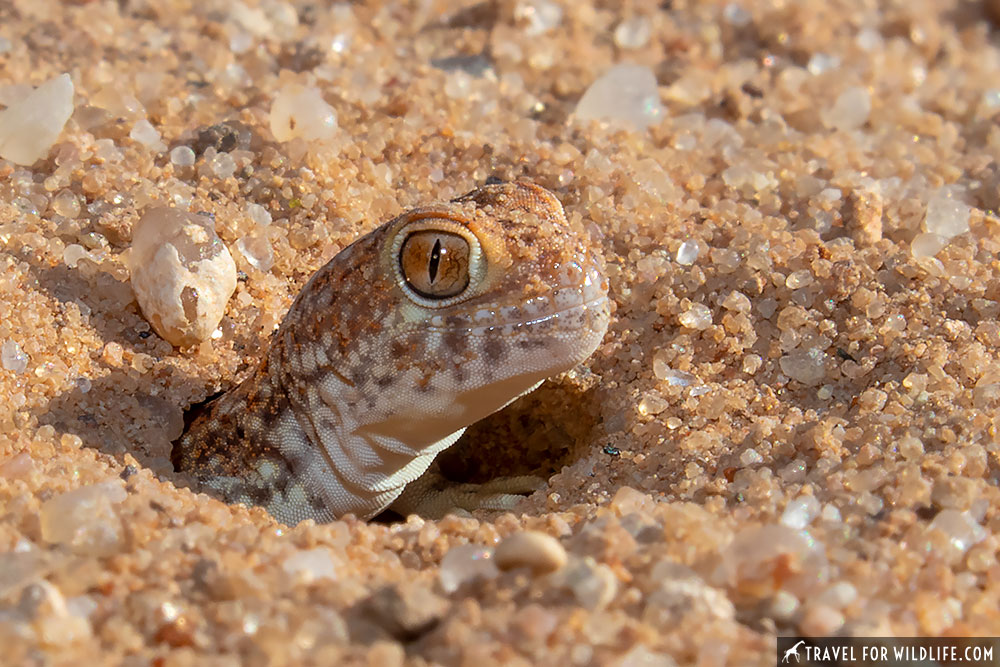
How to Get There
Entering from South Africa. There is no airport in the Kgalagadi Transfrontier Park so you have to drive in. The main entrance gate is at Twee Rivieren at the southern end of the park in South Africa. The closest airport to Twee Rivieren is in Upington, South Africa, about a 2.5 hour drive south of the park. However, if you are flying from another part of the world, the cheapest flights are always to Johannesburg, South Africa.
The downside of flying into Johannesburg is that it’s roughly an 11 hour drive to the Twee Rivieren entrance and a challenge to do in a single day. Also Johannesburg is a big city, annoying to drive through, and not necessarily the safest. Lately some of the towns between Johannesburg and Twee Rivieren are getting less safe for tourists as well, such as Vryburg and Kuruman. (See our article Is South Africa Safe?) Still this is probably the most common way that visitors get to the Kgalagadi.
Another option is to enter through Namibia at the Mata Mata gate. We chose this route in 2020 to avoid some of the headaches in South Africa. We flew into the capitol city of Windhoek, rented a 4×4 camper from Asco Car Hire, and it was then about a 6.5 hour drive to the Mata Mata entrance gate. We chose to stay overnight along the way at one of our favorite stopovers, the Kalahari Anib Lodge, making for easy, pleasant driving the whole way. (stay tuned for an article about visiting the Kgalagadi from Windhoek). Keep in mind that you must cross the international border from Namibia into the park no later that 4:30 PM!
Entering from Botswana. There are actually 3 points you can enter the Kgalagadi from Botswana and each one is rather small and obscure. One is through the Mabuasehube gate which requires driving through remote and challenging sand tracks with a 4×4 (see our article about Traveling to Mabuasehube). The other is through the north end of the park at the Kaa gate which may be even more challenging and remote than the Mabuasehube gate! Thirdly is the little-known fact that you can enter Two Rivers (the Botswana half of the Twee Rivieren rest camp) from a tiny road in Botswana that parallels the main entrance road on the South African side.
When to visit the Kgalagadi Transfrontier Park
In my opinion, any month is a great time to visit the Kgalagadi, but each season has its pros and cons. Being a desert environment, temperatures can be extreme, even within the same day. Summer highs may regularly top 40° C (104°F) and winter lows can reach -10°C (14°F). The seasons work kind of like this:
- October to December: Hot and dry
- December to April: Rainy Season (and still hot)
- May to September: Cold and dry
Visiting in Summer. Our last two trips we visited in January and February. The pros are that fewer people visit this time of year so you have wider options in lodging and you’re more likely to be able to make last-minute bookings. You can sometimes feel like you’re all alone in the park! It is also baby season. We see lots of baby predators (lion cubs galore on our last trip, plus baby leopards!) as well as lots of baby antelope.
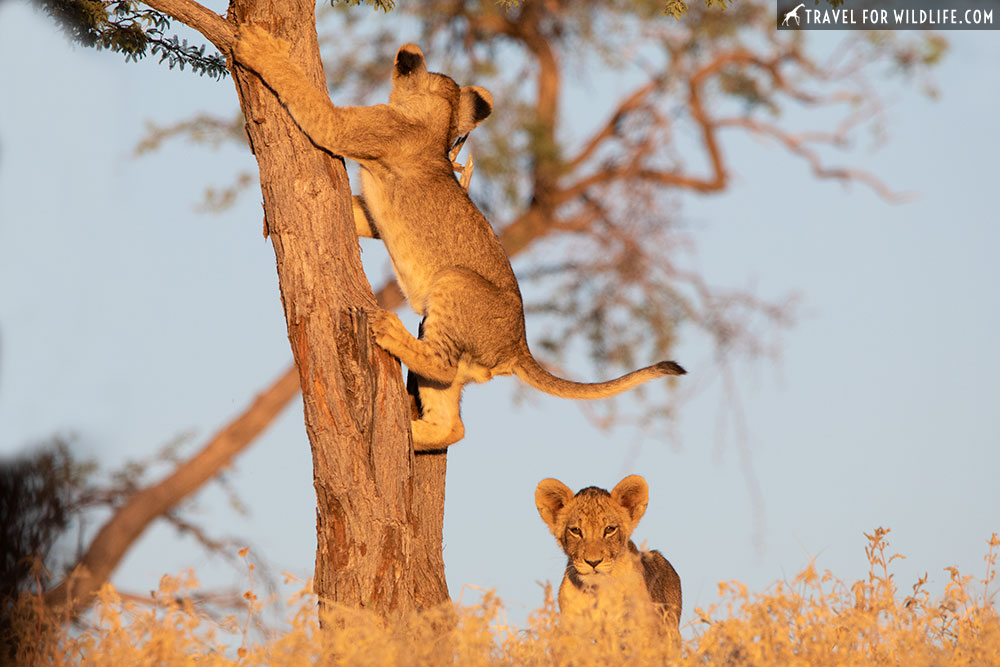
Also, when the rains begin, the flowers bloom! The cons are that it is HOT! Regularly topping 40°C, it is sometimes just too damn hot. Animals don’t tend to be terribly active in extreme heat, but we still get tons of great sightings. Another issue is that the days are much longer in summer. If you want to be out at gate open and at gate close for the golden hours of photography, then you’ve got a long day ahead of you. This makes me pretty exhausted after a while. Sometimes the rains begin in December, sometimes they may wait until February, it just depends on the year. But keep in mind it’s possible to get a lot of rain and roads could occasionally be flooded. If the rains haven’t stared yet, it’s also possible to be really dry and game may have moved out of the region entirely in search of greener pastures!
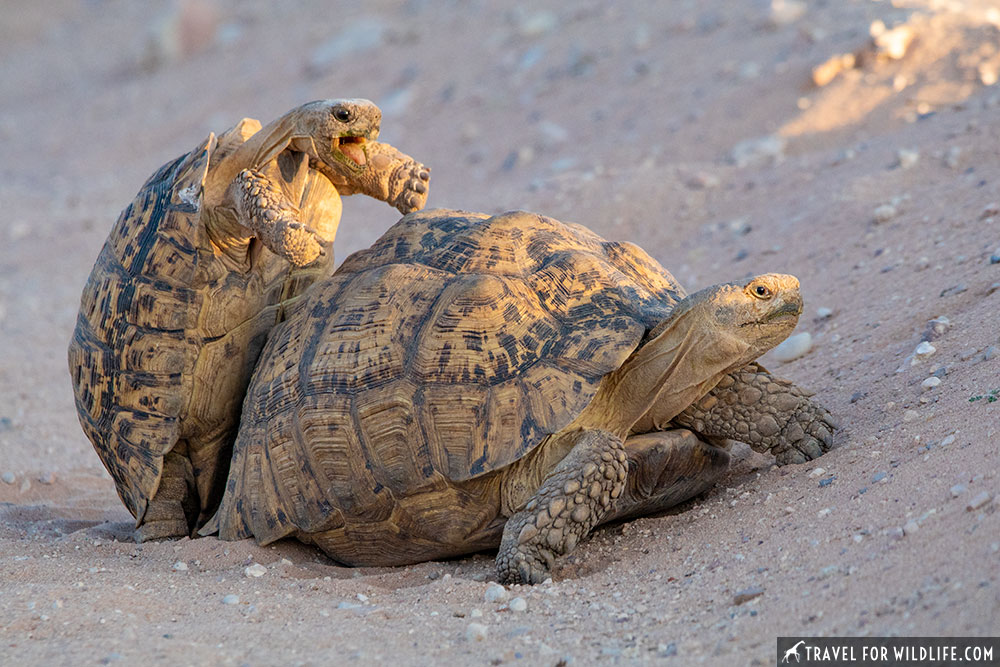
Visiting in Winter. The other extreme is July and August. The pros are that the days are shorter and it’s easier to be out at sunrise and sunset every day for the golden hour light without getting exhausted in the process. Also you have a better chance of seeing nocturnal creatures in daylight on colder days (such as bat-eared foxes and aardwolves). The cold temperatures are a bonus to me because I don’t handle extreme heat well. I’d rather camp in the cold. Cristina is the opposite, she’d rather deal with the heat. That one’s up to you. The cons are that the wilderness camp cabins have no heat and can be pretty chilly in winter. (Though they do have warm blankets and hot water showers if the pipes haven’t frozen.) Also this is when most Europeans have their vacation so it can be crowded.
In Between. March through June (Autumn? aka the green season) and September through December (Spring?) have the most moderate temperatures so it is the most popular time with visitors. March and April are at the end of the rainy season and in wet years the Kalahari will be beautifully green, but the grasses can get tall enough to make viewing difficult. This may make September through November the all-around most favorable conditions for visiting the park, but it all depends on what you like and what you want to see!
Can I Self-Drive in the Kgalagadi?
Yes you can self-drive in the Kgalagadi! In fact, unless you find a private tour that is visiting the park, it is the only way to visit the Kgalagadi Transfrontier Park! Every road in the southern half of the South African side is well-maintained and easy to drive with any vehicle (see “Do I Need a 4×4?” below.)
If you’re not comfortable with driving yourself around in the park, it is possible to drive into Twee Rivieren from South Africa or into Mata Mata from Namibia and simply pay for guided safari drives from the camp. Actually, guided night drives are the only way you’re allowed to drive around at night and we highly recommend them!
Do I need a 4×4 to visit the Kgalagadi?
No, You don’t need a 4×4 to visit the Kgalagadi. The first several times we visited the park, we drove a regular 2-wheel-drive compact car. The trick is to lower your tire pressure to 1.6 bars. This will give you better traction in sand and will cause less washboarding on the roads. However, you can’t reach every area of the park in a 2-wheel drive. Here are the details…
The easiest places to drive in a low-clearance 2-wheel drive car is the southern end of the park. Enter at Twee Rivieren gate and you can easily drive up to the Melkvlei picnic area on the Nossob riverbed, and up to Urikaruus on the Auob riverbed. Also the lower dune cross road and upper dune crossing road are well graveled and no problem for an ordinary vehicle. This gets you to a large chunk of the park and covers most of the prime animal viewing areas. This also gets you access to three camps: Twee Rivieren, Urikaruus, and Kieliekrankie, some of our favorite places to stay! You can also enter from Namibia in a regular sedan vehicle, though you will drive gravel roads for several hours before reaching the park, and stay at the Mata Mata camp. After that, things get a little trickier.
They will tell you that the two main roads are accessible to all vehicles, all the way from Twee Rivieren to Mata Mata on the Auob riverbed and all the way from Twee Rivieren to Union’s End on the Nossob riverbed. But some sections can get quite challenging for a 2-wheel drive vehicle. In my opinion, the worst section is between Urikaruus and Mata Mata where regular traffic combined with some deep sand sections can make for difficult slip-n-slide driving at times. In fact we once got stuck around the 14th waterhole area in the middle of a cheetah jam. Another visitor in a 4×4 towed us out of the soft sand and we were fine, but these conditions can cause you to experience some white-knuckle driving in a regular car.
Similarly, the entire stretch north of Melkvlei up the Nossob riverbed can develop messy sandy patches and deep ruts (as well as obnoxious washboarding.) We have successfully driven a small car the entire Auob riverbed many times and up to Nossob as well, but having a high-clearance 4×4 vehicle makes the whole experience much more pleasant.
Other roads in the park are strictly for 4×4 vehicles. The Botswana side is strictly 4×4, so if you don’t have one or can’t afford to rent one, forget about that side of the park. There are are also two roads on the South African side, the Bitterpan road and the Gharagab road, which are strictly 4×4 and only visitors with a booking at those camps can use them.
Occasionally, in periods of extremely high rainfall, the roads will fill up with water. In these cases it is also useful to have a higher-clearance vehicle. We have bashed through deep puddles in a small compact car before and it is not ideal.
If you can afford to rent a car with higher clearance or 4 wheel drive, choose that one. If you can’t afford a 4×4, you can get by with even a tiny compact car, just stick to the south end of the park.
Where to stay in the Kgalagadi
Whether you’re looking for a rugged camping adventure or a wilderness lodge or just a simple chalet, there are plenty of lodging options available inside the Kgalagadi Transfrontier Park. But they tend to book up far in advance. Many of the wilderness camps open up for online booking a year ahead of time and then fill up instantly! With other camps you may be able to find tent sites or even chalets at the last minute. But don’t be afraid to plan ahead because the cancellation policy is fairly relaxed. Here is a guide to Kgalagadi accommodations:
Where to stay on the South Africa side of the Kgalagadi
Camping Sites: Camping is quite reasonably priced in the Kgalagadi Transfontier park, and there are an abundance of easily-accessed campsites in the three main rest camps: Twee Rivieren, Mata Mata, and Nossob, These are all on the South African side. Some sites have electricity, some don’t. There are even some new “premier” camp sites at Nossob that include your own private bathroom and cooking area. An alternative Kgalagadi camping experience on the South African side is to book the Nossob 4×4 Eco-Trail. To drive the trail you must have a minimum of two vehicles and you will be lead by a park guide in their own vehicle. Along the 4-day trip you will stay at three exclusive wilderness campsites! (Bookings to be made at Twee Rivieren.)
Self-Catering Chalets in the Main Rest Camps: There are a wide variety of chalets available in each of the three main rest camps: Twee Rivieren, Mata Mata, and Nossob. These main camps function like small villages, each with an assortment of lodging (chalets and campsites) a shop, a gas station, a park office, a swimming pool, a viewing hide at a waterhole, and are surrounded by a perimeter fence. The only restaurant is at Twee Rivieren which includes a lunch time take away, and a dinner dining room.
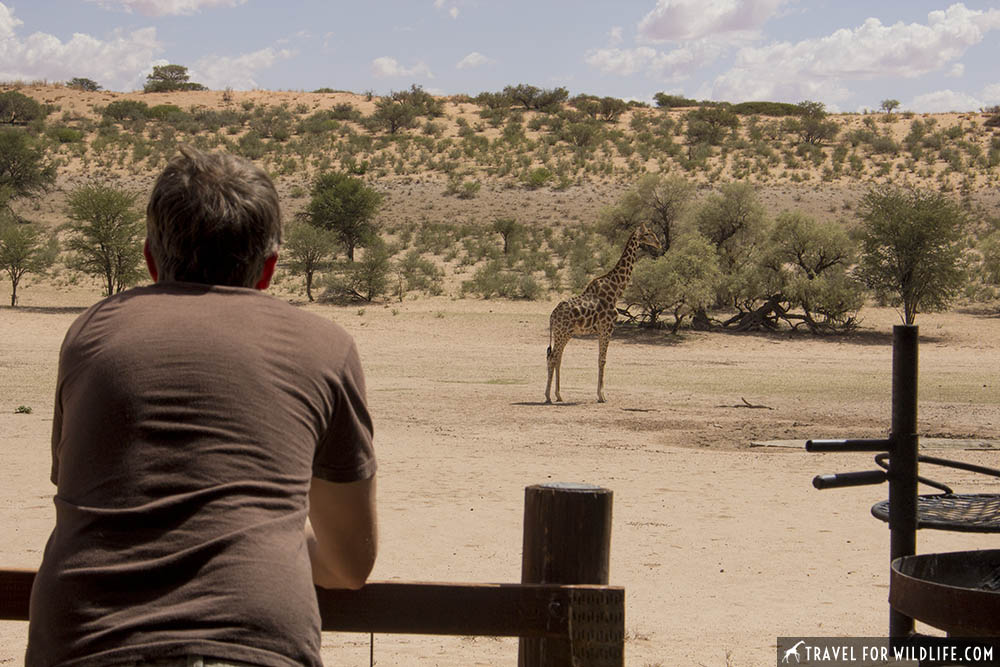
Wilderness Camps: These are the true gems of the Kgalagadi Transfrontier Park. Though they are called “camps”, there is no camping involved. In fact, each is a beautifully designed set of four cabins in a remote wilderness area of the park with no fences around it, meaning any animal may wander through at any time. For this reason, children under 12 are not allowed to stay in the wilderness camps. (But all other campsites & chalets on the South Africa side are fine for kids.) The highlight of each wilderness camp is that it overlooks a waterhole which you can watch all night to see rare nocturnal creatures like leopards, caracals, & hyenas.
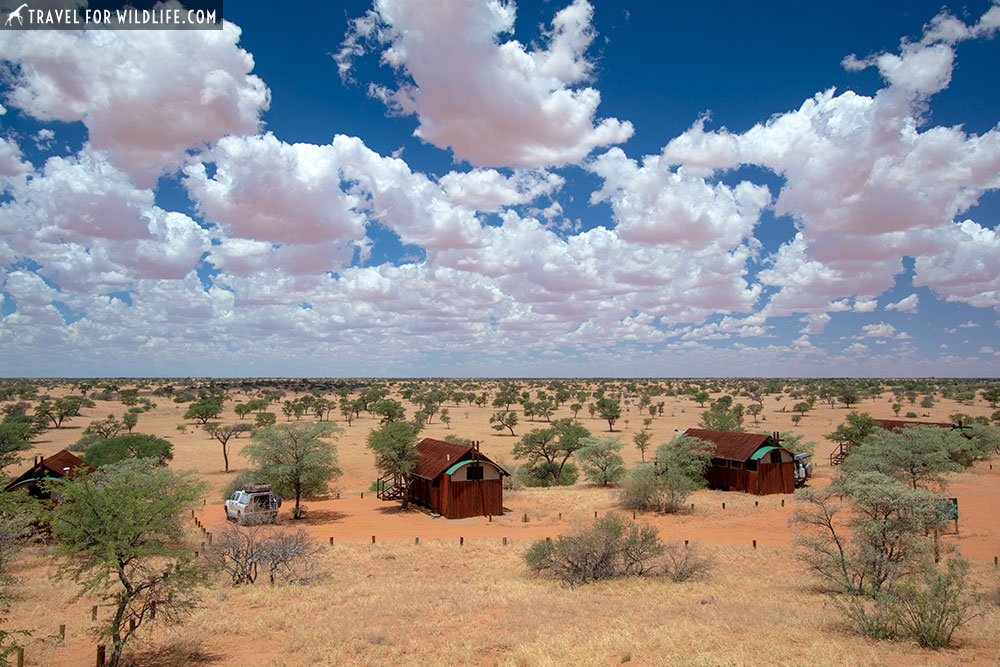
They are not fancy but they do have comfortable beds, bathrooms with hot water showers, and fully functional kitchens with refrigerator/freezer, gas stove, and all cutlery and cookware. Keep in mind that electricity is provided by solar panels so they don’t provide any power outlets, and the borehole water is too salty to drink so bring your own. To me these are the best value in African safari lodging, hands down. But because of that they book far in advance and are hard to get! Each wilderness camp has only four units, except Urikaruus which has an additional “honeymoon cabin” and the Kalahari Tented Camp which has 12 units. Here is a list of the camps. You can also click on their link for a more in depth review of each camp.
Kgalagadi Wilderness Camps
- Urikaruus (5 units)
- Kieliekrankie (4 units)
- Kalahari Tented Camp (15 units)
- Grootkolk (4 units)
- Gharagab (4 units)
- Bitterpan (4 units)
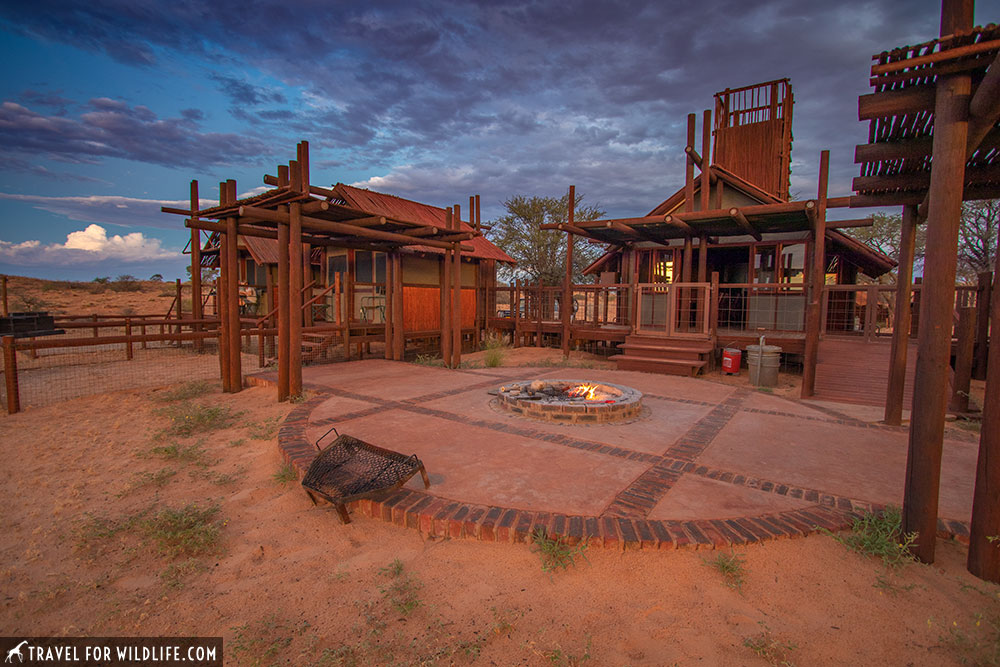
Lodges: There is only one lodge on the South African side of the park and it is called !Xaus Lodge. (Pronounced “Kaus”.) While it is essentially designed like the other wilderness camps, this luxury lodge has 12 chalets, and includes a common area where 3 meals a day are served. All activities and game drives are included. The lodge is located on the western edge of the park between the San Heritage Land and the Miera Heritage Land. While the lodge is a bit pricey, it has the great benefit of helping preserve San culture and providing an authentic cultural experience.
Where to stay on the Botswana side of the Kgalagadi
The lodging options on the Botswana side of the Kgalagadi Transfrontier Park are limited to primitive wilderness camping and two lodges.
Botswana Kgalagadi Camping. There are three main camping areas on the Botswana side of the Kgalagadi:
1) The “front country” camping areas are easily accessible from the main Nossob road (just across the Botswana border). These include the Two Rivers campground, the Rooiputs campground, and the Polentswa campground. Each of these camping areas has a limited number of sites (3 to 6) with very few facilities. They are unfenced and most have only an A-frame structure for shade and a pit toilet. While they are fairly close to the main road, the access road may have deep sand and be challenging for a 2-wheel-drive vehicle. Therefore they are marked as 4×4 only.
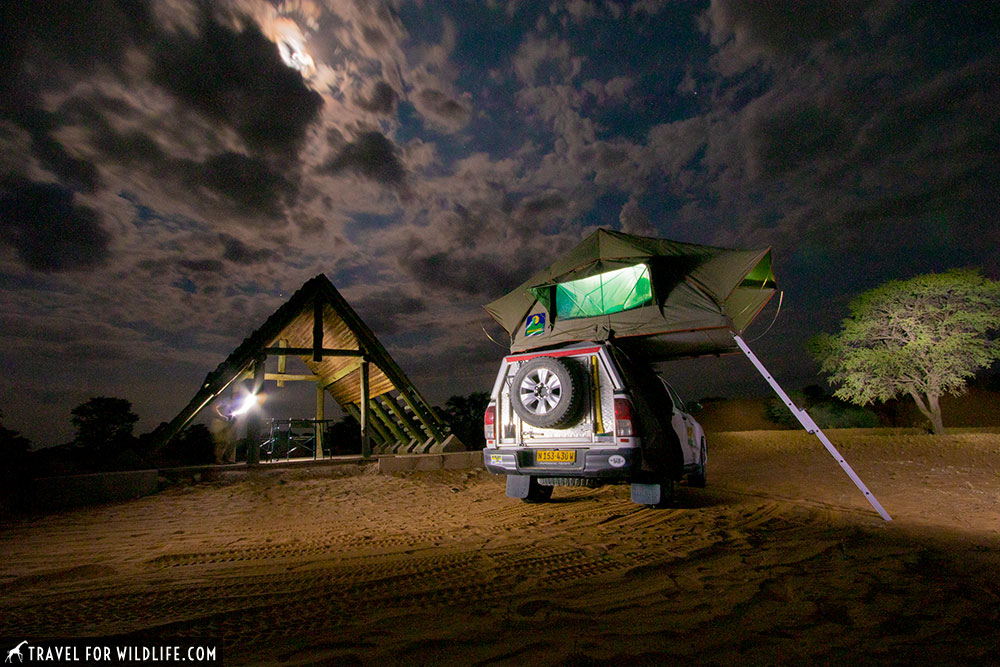
2) The Mabuasehube area. In the extreme eastern edge of the park lies the remote Mabuasehube camp sites. There are only 17 sites and they are primitive, like the ‘front country’ ones above. However, these sites are far off the beaten path and require a 4×4 to get there. Read our Complete Guide to the Mabuasehube Campsites and our companion article Traveling to Mabuasehube.
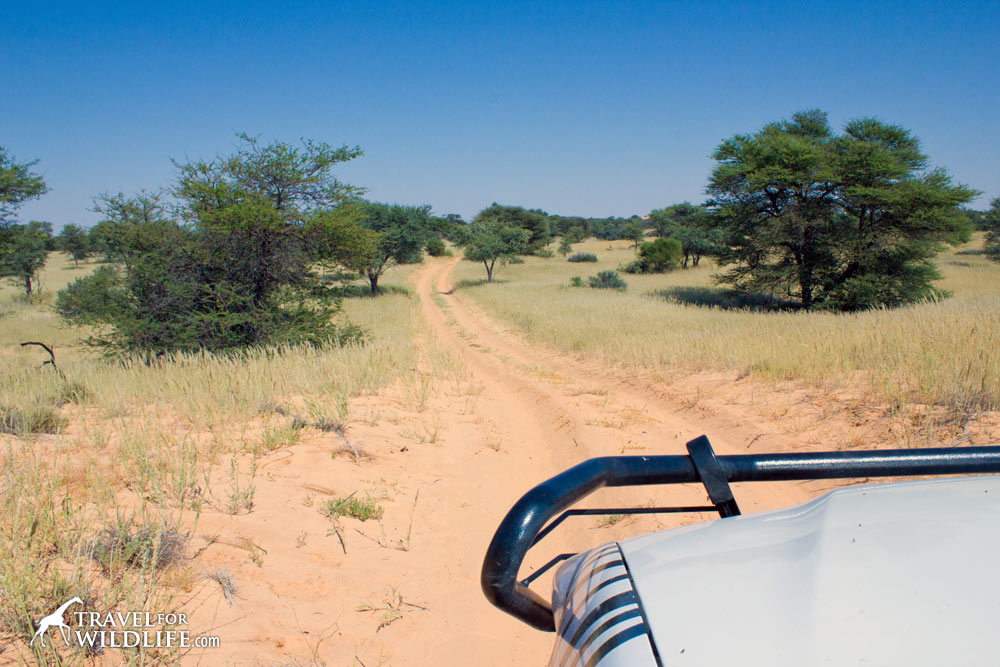
3) The Kaa region.The remote northern end of the Kgalagadi Transfrontier Park is known as the Kaa region. There are a few 4×4 trails that can be followed to a series of primitive wilderness campsites. There are generally lower wildlife concentrations here so Kaa is more about a remote wilderness adventure than wildlife viewing
Lodges in the Botswana side of the Kgalagadi.
There are two lodges located on the Botswana side of the Kgalagadi, both managed by Ta Shebube. One is the Rooiputs Lodge and the other is the Polentswa Lodge. Visit the Ta Shebube website for more information.
Where to stay outside of the Kgalagadi Transfrontier Park
If you just want to pop into the park for day trips, keep in mind that the park limits the number of day visitors that can enter each day to 20 cars maximum. Call reception for more info (054-561-2000).
Another reason you may want to stay outside the park is that you might find yourself arriving too late to enter the park before gate closing time. If you’re entering from South Africa at the main Twee Rivieren gate, your best option is the Kgalagadi Lodge just 5 km from the gate. It has comfortable chalets with a nice view, campsites, and an excellent restaurant and shop. Another nice option is Kalahari Trails about 35 km south of the entrance. They offer excellent walking tours and rescue meerkats!
If you’re coming in from Namibia through Mata Mata, keep in mind the border crossing closes at 4:30 PM so if you arrive after that you’ll need to find accommodation outside the park in Namibia. There is a small Farmstall just 200 meters from the border that has a few chalets and campsites, and another called Kalahari Farmstall & Accommodation about 15 km back with reasonably priced chalets, camping and a nice coffee shop on site.
If you’re entering from Botswana at either the Mabuasehube gate or the Kaa gate you won’t find any nearby lodging options so plan ahead!
How to Book accommodation in the Kgalagadi
If you want to book accommodation in the South African side of the Kgalagadi, or check SANParks availability, the easiest way is through the SANparks website It is well organized and efficient. You can pay with credit card through the website. But wilderness lodges do tend to book up far in advance so plan ahead! Here is some more contact information for Kgalagadi reservations on the South Africa side.
Contact South Africa Kgalagadi Transfrontier Park Reservations
- SANParks Central Reservations Tel: 012-428-9111
- E-mail: reservations@sanparks.org
- Web: sanparks.org
- Kgalagadi Transfrontier Park phone: 054-561-2000
To make reservations at the lodges on the Botswana side (Rooiputs lodge and Polentswa lodge) you can book them through the Tashebube website.
If you want to camp on the Botswana side…well that is more complicated. In fact, it is so complicated that we’ve dedicated a whole article to it. Check out our post Camping in Botswana: How to Make a Reservation. If you’re staying in Mabua then check which campsite you’d like to stay in with our guide to Mabuasehube campsites. (Also stay tuned for a post about camping at Polentswa, Rooiputs, and Two Rivers on the Botswana side, coming soon.)
Contact Botswana Reservations for Kgalagadi Transfrontier Park
- DWNP reservations Tel: +267-318-0774
- Email: dwnp@gov.bw
What to Bring
Having visited many times we’ve developed a list of items that we can’t live without in the Kgalagadi. Here are some of those items For tips on the photography items we bring, see Kgalagadi Photography Tips in the next section. Also check out our article How to Choose Your Safari Shoes.
- headlamp (Petzl Aktik Core)
- high powered flashlight for waterhole viewing at wilderness camps (Olight) Please use a red filter to not bother wildlife.
- solar powered lantern (both for camping & in the wilderness camp cabins)
- cigarette lighter inverter for charging batteries while driving
- compact binoculars
- silicon popsicle molds (an awesome treat in the remote wilderness camps!)
- South Africa power adapter (from your country!)
Here is a list of our favorite guide books we always bring to the Kgalagadi. For more, see our article Books to Take on an African Safari.
- A Natural History Guide to the Arid Kalahari
- Animals of the Kgalagadi
- Birds of Southern Africa (Robert’s Bird Guide is another good one)
- The Behavior Guide to African Mammals
- On Track (ID Guide to Southern African Animal Tracks)
Kgalagadi Photography Tips
The Kgalagadi Transfrontier Park is amazing for wildlife photography. Low and open vegetation makes for unparalleled viewing and visibility. An incredibly array of predators, both mammalian and avian, makes for lots of exciting wildlife photo opportunities.Here are a few of our Kgalagadi photography tips. Also check out our post about The Jumping Jackals of Nossob & How to Photograph Them.
Lenses. Do you need to have a super telephoto 600mm lens? No. Often animals will be standing right next to the road. However, you should give animals their space so that 1) you don’t frighten them and cause them to expend energy unnecessarily and 2) to keep your distance from potentially dangerous animals like lions & leopards. For that reason, I think it makes sense to bring the longest lenses you can afford. I used to use big monsters like the Nikon 600 f4 the Canon 500 f4. Yes they take amazing photos, but they are also a pain in the butt to travel with and ridiculously expensive.
If you want to photograph birds, a long lens is indispensable. On our last trip I shot with a Sigma 150-600mm and I really enjoyed it. It’s a light-weight, versatile lens for a great price. Keep in mind that it has a smaller max aperture which makes it tougher to get sharp photos and rich color in lower light situations. However, the huge zoom range allows you to capture the best composition in any situation, not just a closeup of a face. Don’t forget a wide angle for all those beautiful landscapes!
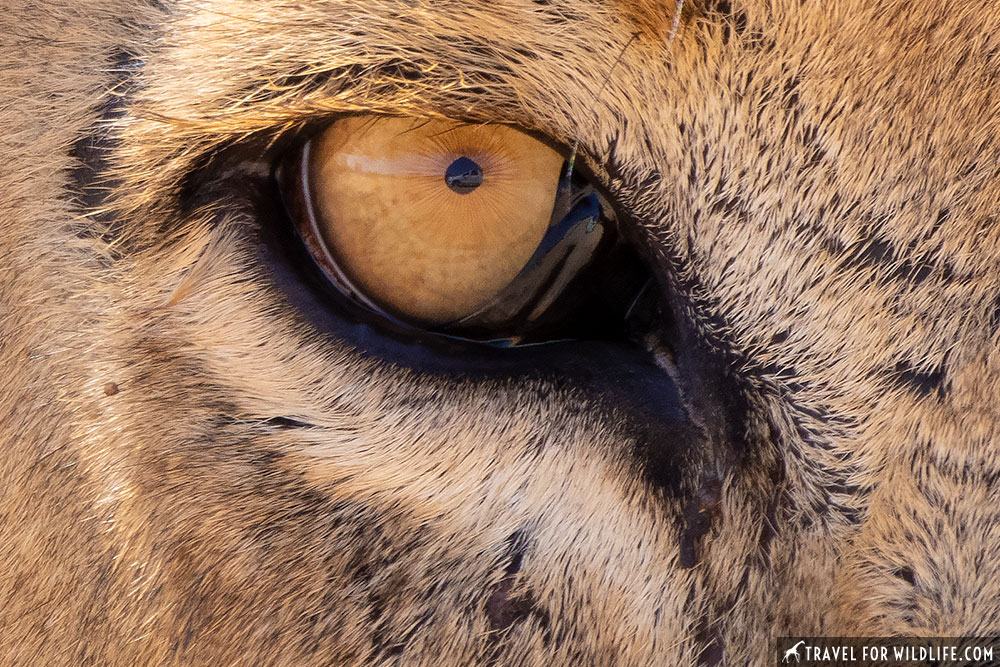
Bring a bean bag. Keep in mind that you are not allowed to get out of your car in the park, except in a couple designated picnic areas. This means most of your photos are taken out of a car window. Many locals in Southern Africa who are regulars in the park have added custom mounts to the outside of their car door for mounting heavy lenses. Since this isn’t really an option for visitors renting a car, I still find that a good old-fashioned bean bag is the best option. On my first visit to Africa decades ago I made a bean bag out of the leg of an old pair of jeans and used the fly to close it up. I still use the same one today. I bring it empty and then fill it with bags of rice, (still in the plastic package) when I arrive. Then I have an emergency food source too! There are plenty of commercial options available as well. Forgot to bring a bean bag? Throw a large bag of rice into a drawstring sack. Boom, good to go.
Should I bring a tripod? That depends. As stated above, you’ll spend most of your time shooting from a car where a tripod isn’t really an option. On the other hand, if you’ll be staying in some of the wilderness camps (see Where to Stay below) then a tripod is very useful. Each wilderness camp has a deck or patio from which you can photograph the waterhole. While there are railings around these decks that you can plop a bean bag on top of, a tripod makes much more sense here.
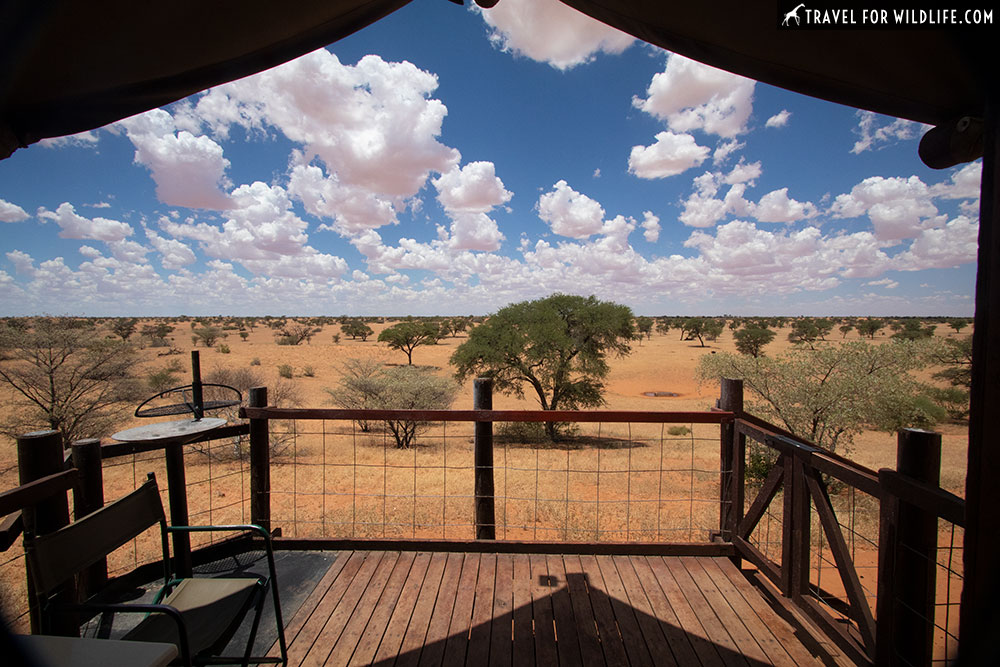
Shooting at Night. As mentioned above, the wilderness camps offer you a rare chance to photograph hard-to-see nocturnal predators at the camp waterholes. While there is always a light shining on the waterhole, these tend to be too dim for shooting. Yes you can shoot with an insanely high ISO and get a grainy picture that is exposed well if your subject is holding still. But a better bet is to bring a powerful flashlight. (See our What to Bring section above.) Remember not to overdo it with flashlights. It is unpleasant for the animals to have a bright light shining in their face and can cause temporary blindness, making them vulnerable to predators. Instead, shine the light next to them. Also it can call attention to prey animals who may be trying to avoid predators, or predators trying to hunt. Another option is to bring a strong flash, possibly with a flash extender. But even this combination may have trouble reaching the distance to most waterholes.
Rules when visiting the Kgalagadi
Adhere to the gates hours at every camp. You must be inside one of the main camps, wilderness camps, or designated camping sites every single night you are in the park. You have to be back in camp by gate closing time and you can’t leave camp until gate opening time in the morning. These times vary from month to month based on sunrise and sunset, but are consistent between every camp in the park. You can find them in the park guide, posted at every camp gate, and listed below. Keep in mind that on your day of arrival you need to enter the park with enough time to drive (under the speed limit) to your first reserved restcamp or else they will not let you enter the park! Don’t worry, there are a few lodging options outside the park.
Kgalagadi Transfrontier Park Gate Times:
- January 5:30 AM to 7:30 PM
- February 6:00 AM to 7:30 PM
- March 6:30 AM to 7:00 PM
- April 7:00 AM to 6:30 PM
- May 7:00 AM to 6:00 PM
- June 7:30 AM to 6:00 PM
- July 7:30 AM to 6:00 PM
- August 7:00 AM to 6:30 PM
- September 6:30 AM to 6:30 PM
- October 6:00 AM to 7:00 PM
- November 5:30 AM to 7:30 PM
- December 5:30 AM to 7:30 PM
Do not speed. Speed limit in the park is 50 km/hour. If you are at an awesome sighting and it’s getting late, I’m sorry but you have to leave. If you get to your restcamp later than gate closing time you’ll be fined. They also have random radar speed checks along the roads, and they will get you. So please don’t speed.
Do not feed wildlife. This includes providing bird baths to birds.
Do not play music. Respect your neighbors (people or wildlife). The official guide states “no noise whatsoever between 9pm and 7am.”
Do not get out of your car while in the park, not even half your body outside the window or door or sunroof. You’ll be fined if you do and other guests are likely to report you if they see you. You are only allowed to get out at rest camps and in designated areas (such as the picnic areas) but you do this at your own risk and you must look around and pay attention!
Do not drive off road. The Kalahari is a fragile ecosystem, and any damage might take decades to heal.
No drones. As with all national parks in South Africa (and most of the world) the use of camera drones inside and over the park is strictly prohibited. If you travel with a drone you must disclose that at Reception.
Other assorted rules:
- Do not gather firewood
- Lower your tire pressure to 1.6 bars to reduce washboarding & get better traction
- Keep your eyes open for snakes and scorpions when walking around the camps at night and carry a flashlight
What to do if you see someone breaking the rules? Take photos of the infraction, including a clear photo of the car’s license plate. Then you can take it to the ranger on duty (ask at reception). With the number plate they can trace where the guest is staying and they’ll be issued a fine. This way you avoid an unpleasant interaction.
In addition, please refer to our Safari Etiquette Guide for some tips on what to do and what not to do when watching wildlife while on a safari.
Frequently Asked Questions:
Do I need a passport?
If you are entering and leaving the park through the same country you don’t need a passport. But if you are entering the park through one country and leaving the park through another country, you do. The Botswana and South Africa passport control office is in Twee Rivieren (called Two Rivers in Botswana). If entering from or exiting into Namibia, your passport control office is in Mata Mata. The border post hours are:
Twee Rivieren: 7:30 am to 4 pm
Mata Mata: 8 am to 4:30 pm
So if you are entering the park through Mata Mata you need to be at the gate before the border post closes (4:30 pm). If you arrive after gate close, you can find accommodation near Mata Mata, (See Where to Stay Outside the Park above).
How do I contact the Kgalagadi National Park office?
Please note that we they are unable to assist with reservations. Contact 012 428 9111/reservations@sanparks.org/ www.sanparks.org for reservations.
Kgalagadi National Park phone numbers:
Emergency and Duty Number: 073 224 3484
Twee Rivieren Duty Manager: 054 561 2029
Twee Rivieren Reception: 054 561 2005 / 2050
Can I enter the park if I don’t stay in the park overnight?
Yes you can. A maximum number of 20 cars per day are allowed to recieve a day pass. You need to enter and leave through the same gate. Most of these visitors stay at the Kgalagadi Lodge, just south of the Twee Rivieren entrance.
Can I bush camp in the wilderness or on the side of the road?
No, wild camping is not allowed in the park, only in pre-booked, designated campsites. In fact, if you don’t have accommodation (chalets or camping) booked you won’t be let in (unless you’re one of the 20 vehicles each day who are given a daily pass).
Can I just drive through the park to cross into another country in one day?
No, you can’t. The rules state that you need to stay in the park for a minimum of two nights. This is to discourage people from speeding and creating problems for others.
Is the Kgalagadi malaria free?
Yes, the Kgalagadi is malaria-free. While there are, on rare occasions, a few mosquitoes in the park (during times of heavy rain), the Kgalagadi Transfrontier Park is outside the malaria zone.
Are the camp shops well stocked?
Whenever we visit, we do our main shopping before arriving at the park, either in Upington in South Africa or in Mariental in Namibia. Then we get remaining necessities at the shops in the park. While their offerings are not amazing, we’ve always survived. The main shop at Twee Rivieren is the one with the most variety. You’ll find dry goods, wine, frozen meat, snacks, water, firewood, yogurt, cheese, and some veggies (tomato, cucumber, lettuce…) pretty basic but you’ll even find ice cream and the only cashpoint in the park! (see Is There an ATM in the Park below.
The Nossob and Mata Mata shop are much smaller with fewer products. Fresh produce is harder to find so get some if you see it! If you need something specific, get it before you enter the park. If you are buying alcohol remember that under South African law no alcohol is sold on Sundays. And ladies, bring your tampons with you, because Cristina couldn’t find any!
Is there an ATM in the park?
Yes, there is an ATM (cashpoint) in the shop at Twee Rivieren, but note that sometimes it doesn’t have any cash in it! Often you’ll be told that they’ll put some cash in at 3:00 PM at the employee shift change when they empty the drawer. We’ve also been told that if the ATM is out of cash you can go to reception and they can give you cash using your debit card, though we haven’t tried it personally.
What currency can I use?
You must use South African rands in the South African side and Pula in the Botswana side. Namibian dollars are not accepted (but they accept them for border fees when entering or exiting the Mata Mata border post to Namibia.)
Are there gas stations in the park?
Yes, there is a gas station in each one of the main rest camps (Twee Rivieren, Mata Mata, and Nossob). While prices are understandably a bit higher than outside the park, it isn’t outrageous. They do accept credit cards. Keep in mind that on some occasions it can get so hot in the afternoon that the pumps won’t function, so you’re better off refueling in the morning or evening on very hot days!
Is there wifi in the Kgalagadi?
Yes, there is. But only at the three main restcamps. Signal is very weak and you’ll only be able to pick it up by the shop at each of the camps. You’ll need a voucher to get wifi, purchased in the shops for 75R.
If you have a South African mobile phone card, you can pick up signal only at Twee Rivieren. If you have a Namibian mobile phone card they say you can get signal at Mata Mata but that was not the case for us. I don’t think you can get Botswana signal anywhere in the park.
Do I need to bring my own water?
One thing to remember is that water is very scarce in the Kalahari. Please use it responsibly.
If you are staying at the main camps (Twee Rivieren, Mata Mata, and Nossob), water is available but you might want to bring your own drinking water. (You can buy drinking water at each of the camps in both large and small bottles.) If you are staying in the wilderness camps or are camping in the remote Botswana sites, you need to bring your own drinking water. The water in the wilderness camps comes from boreholes (wells) and it is very salty/mineralized. While this is the water you’ll use for showering and dishwashing, it is not advisable to drink it.
Conclusion
The Kgalagadi Transfrontier Park isn’t for everyone. It definitely is NOT Kruger. But we find the challenges to be worth it. We are sometimes hesitant to promote it, because if tourism continues to grow and that growth isn’t managed properly, it could destroy the very place we love so much. If you visit and become a Kalahari fanatic like we are, then let’s all work together to protect this special place for generations to come.
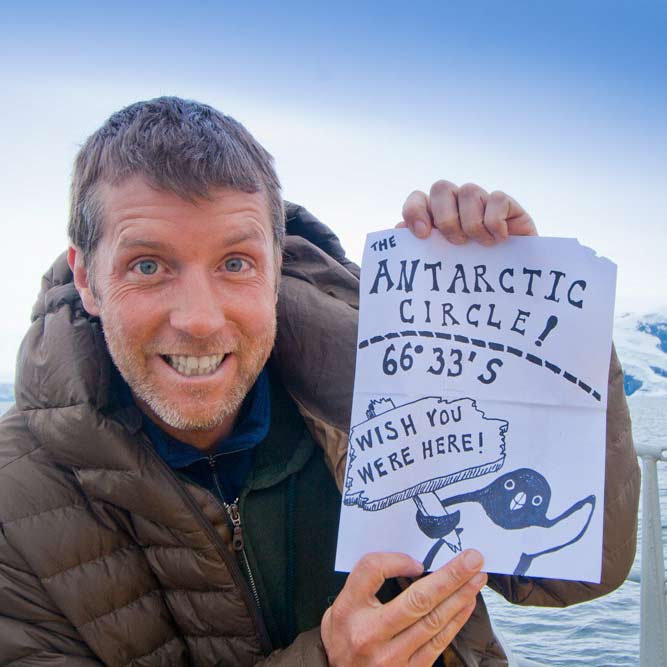
Hal Brindley
Brindley is an American conservation biologist, wildlife photographer, filmmaker, writer, and illustrator living in Asheville, NC. He studied black-footed cats in Namibia for his master’s research, has traveled to all seven continents, and loves native plant gardening. See more of his work at Travel for Wildlife, Truly Wild, Our Wild Yard, & Naturalist Studio.

Sylvie
Sunday 28th of May 2023
Hello again, I forgot to ask: is there anywhere where I can see (fairly tame) bush babies? I can't imagine that the vegetation in the Trans Frontier would work for them, but I'm in love with them too and I know that there is a feeding station at Nata, where it's very easy to take photos... but anything similar in the Trans Frontier ??? (and I DO realise that bribing animals with food is really, really bad practice... but I wouldn't be the one doing it ;). Thanks again for this great article ! Sylvie
Sylvie
Sunday 28th of May 2023
@cristina garcia - Thank you SO much for the prompt response. I'll definitely take your article with me next time I revisit Kruger. Happy & Safe Travels :)
cristina garcia
Sunday 28th of May 2023
Hi Sylvie,
There are no bush babies in the Transfontier park. We have seen them in Kruger National Park and in KwaZulu-Nata. Pretty easy to see them if you look up on the trees at night as they are around the campground in Kruger. Here's a post we wrote on where to see see them. Hope you see them! https://www.travel4wildlife.com/where-to-see-bushbabies-in-south-africa/
Sylvie
Saturday 27th of May 2023
This is one of the best travel articles I've EVER read (and I must have read *hundreds* over the last 3 decades as I'm addicted to travelling too). SO very thorough.. THANK YOU.
I am actually hoping to go and visit the Trans Frontier park this late Oct/early Nov but of course, as you said, it's already too late to secure accommodation in most places.... eeeek. I'll keep trying. I don't drive, which is THE big flaw in my plan, so I would have to rely on a good friend who lives in Jo'burg to bring me over. She's in love with the park too.
SO many people have told me that this place is 'surreal' and 'a photographer's dream'.... but your article has totally validated this.
Once again, thank you !!! I can't imagine how long it must have taken you to write ALL this and remember so many details.
Happy travels :) Nature is an endless source of wonder... always leaves me in awe.
"Life is not measured by the number of breaths we take, but by the moments that take our breath away" (George Carlin)
Sylvie, from London... but my heart lives wherever wildlife abounds ;)
Helen Mclachlan
Monday 31st of January 2022
Thanks a lot for the info, we’re going in April, and although we’d read most of what you’ve put up it was lovely to hear it from your point of view and excite us again about our nearly imminent trip? we really can’t wait to try somewhere different from Kruger, as much as we love it there ?? ..
cristina garcia
Saturday 12th of February 2022
You are welcome Helen! Hope you have a fantastic trip!
Stephanie
Saturday 13th of November 2021
I think we got stuck in the sand around the same area as you did when we went over 4 years ago. At that time the Sanparcs website still said a 2wd with high clearance was enough but we had to get towed and were advised not to go to Nossob as the road was even worse there. The day after on our way back to Twee Rivieren we should not even stand still to watch the animals in certain sections. If all goes right, we'll go back in March but would not go back without a 4x4
Hal Brindley
Saturday 13th of November 2021
Yep, there are some challenging spots, even on the main roads in the South African side. There have been plenty of times I was afraid to stop to look at animals where the sand looked too soft and deep!
Chris Wilson
Thursday 18th of June 2020
Thanks, we are planning, 'Rona' permitting, a 4 mnth trip next year. Leaving Jhb early May with 1 night in Kimberley and 2 nights in Khamkirri before 12 in the Kgalagadi, then on through Namiba, with short sojourns in Zim and Bots. Even at this stage confirming camping and chalets in the Kgalagadi is difficult and the phone call to the Botswana Parks was surprisingly unhelpful 'call again in October'. We will. Until then I will try and cover the 2 nights we had planned in Polentswa by trying to book Nossob. Apparently all the Wilderness camps are already booked out so our proposed 2 day repieve at Kieliekrankie is off the table. I loved your article and have bought some of the books I do not have on eBay this evening. I have made many notes - Thanks I travel with 3 zoom lens' 1. Tamron 150 - 600, f5 - 6.3 2. Tamron 18 - 400, f3.5 - 6.3 (the ultimate travel lens) and 3. Sigma 10 - 20, f3.5 I did not have the 18 - 400 on my last trip (Nairobi - Cape Town), I used a Nikkor 18 - 55, this new acquisition fills the gap far better. Thanks and stay safe
cristina garcia
Thursday 2nd of July 2020
Yes, I've heard that the guys at Botswana Parks are now working from home and contacting them is an adventure! I advice to check on Sanparks a lot (I check every day when we are planning a trip) as there are always cancellations. By doing this one year I found space at Urikaruus for 11 nights, including New Year's Eve!) Keep checking. Good luck!